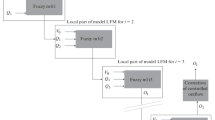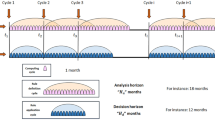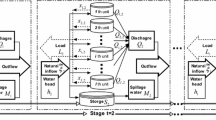Abstract
A dynamic programming fuzzy rule–based (DPFRB) model for optimal operation of reservoirs system is presented in this paper. In the first step, a deterministic dynamic programming (DP) model is used to develop the optimal set of inflows, storage volumes, and reservoir releases. These optimal values are then used as inputs to a fuzzy rule–based (FRB) model to establish the general operating policies in the second step. Subsequently, the operating policies are evaluated in a simulation model. During the simulation step, the parameters of the FRB model are optimized after which the algorithm gets back to the second step in a feedback loop to establish the new set of operating rules using the optimized parameters. This iterative approach improves the value of the performance function of the simulation model and continues until the satisfaction of predetermined stopping criteria. This method results in deriving the operating policies, which are robust against the uncertainty of inflows. These policies are derived by using long-term synthetic inflows and an objective function that minimizes its variance. The DPFRB performance is tested and compared to a model, which uses the commonly used multiple regression–based operating rules. Results show that the DPFRB performs well in terms of satisfying the system target performances and computational requirements.
Similar content being viewed by others
References
Bhaskar, N. R. and Whitlach Jr., E. E., 1980, ‘Deriving of monthly reservoir release policies’, Water Resources Res. 16(6), 987–993.
Cancelliere, A., Giuliano, G., Ancarani, A., and Rossi, G., 2002, ‘A neural networks approach for deriving irrigation reservoir operating rules’, Water Resources Manage. 16, 71–88.
Chandramouli, V. and Raman, H., 2001, ‘Multireservoir modeling with dynamic programming and neural networks’, J. Water Resources Plan. Manage. 127(2), 89–98.
Dubovin, T., Jolma, A., and Turunen, E., 2002, ‘Fuzzy model for real-time reservoir operation’, J. Water Resources Plan. Manage. 128(1), 66–73.
Johnson, S. A., Stedinger, J. R., and Staschus, K., 1991, ‘Heuristic operating policies for reservoir system simulation’, Water Resources Res. 27(5), 673–685.
Karamouz, M. and Houck, M. H., 1982, ‘Annual and monthly reservoir operating rules’, Water Resources Res. 18(5), 1337–1344.
Koutsoyiannis, D. and Economou, A., 2003, ‘Evaluation of the parameterization-simulation-optimization approach for the control of reservoir systems’, Water Resources Res. 39(6), 1170, 1–17.
Lund, J. R. and Guzman, J., 1999, ‘Derived operating rules for reservoirs in series or in parallel’, J. Water Resources Plan. Manage. 125(3), 143–153.
Lund, J. R., and Ferreira, I., 1996, ‘Operation rule optimization for Missouri River reservoir system’, J. Water Resources Plan. Manage. 122(4), 287–295.
Nalbantis, I., and Koutsoyiannis, D. 1997, ‘A parametric rule for planning and management of multiple-reservoir systems’, Water Resources Res. 33(9), 2165–2177.
Oliveira, R. and Loucks, D. P. 1997, ‘Operating rules for multi-reservoir systems’, Water Resources Res. 33(4), 839–852.
Panigrahi, D. P. and Mujumdar, P. P., 2000, ‘Reservoir operation modeling with fuzzy logic’, Water Resources Manage. 14, 89–109.
Philbrick, C. R. and Kitanidis, P., 1999, ‘Limitations of deterministic optimization applied to reservoir operations’, J. Water Resources Plan. Manage. 125(3), 135–142.
Ponnambalam, K., 2002, ‘Optimization in water reservoir systems’, in P. M. Padalos and G. C. R. Mauricio (eds), Handbook of Applied Optimization, Oxford University Press; ISBN: 0195125940, pp. 933–943.
Ponnambalam, K., Karray, F., and Mousavi, S. J., 2003, ‘Minimizing variance of reservoir systems operations benefits using soft computing tools’, Fuzzy Sets Syst. 139(2), 451–461.
Ponnambalam, K., Mousavi, S. J., and Karray, F., 2001, ‘Regulation of Great lakes reservoir systems by a neuro-fuzzy optimization model’, Int. J. Comput. Anticipat. Syst. 9, 273– 285.
Raman, H. and Chandramouli, V., 1996, ‘Deriving a general operating policy for reservoirs using neural networks’, J. Water Resources Plan. Manag. 122(5), 342–347.
Russel, S. O. and Camplell, P. E., 1996, ‘Reservoir operating rules with fuzzy programming’, J. Water Resources Plan. Manage. 122(3), 165–170.
Shrestha, B. P., Duckstein, L. E. and Stokhin, Z., 1996, ‘Fuzzy rule-based modeling of reservoir operation’, J. Water Resources Plan. Manage. 122(4), 262–269.
Sugeno, M., 1985, Industrial Applications of Fuzzy Control, Elsevier, Amsterdam.
Yakowitz, S., 1982, ‘Dynamic programming applications in water resources’, Water Resources Res. 18(4), 673–696.
Yeh, W. W-G., 1985, ‘Reservoir management and operation models: A state of the art review’, Water Resources Res. 21(12), 1797–1818.
Young, G. K., 1967, ‘Finding reservoir operating rules’, J. Hydrol. 93(6), 297–321.
Author information
Authors and Affiliations
Corresponding author
Rights and permissions
About this article
Cite this article
Mousavi, S.J., Ponnambalam, K. & Karray, F. Reservoir Operation Using a Dynamic Programming Fuzzy Rule–Based Approach. Water Resour Manage 19, 655–672 (2005). https://doi.org/10.1007/s11269-005-3275-3
Received:
Accepted:
Issue Date:
DOI: https://doi.org/10.1007/s11269-005-3275-3




